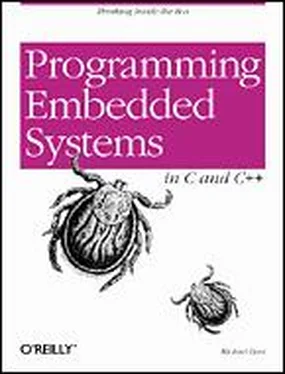Michael Barr - Programming Embedded Systems in C and C++
Здесь есть возможность читать онлайн «Michael Barr - Programming Embedded Systems in C and C++» весь текст электронной книги совершенно бесплатно (целиком полную версию без сокращений). В некоторых случаях можно слушать аудио, скачать через торрент в формате fb2 и присутствует краткое содержание. Год выпуска: 1999, ISBN: 1999, Издательство: O'Reilly, Жанр: Программирование, Компьютерное железо, на английском языке. Описание произведения, (предисловие) а так же отзывы посетителей доступны на портале библиотеки ЛибКат.
- Название:Programming Embedded Systems in C and C++
- Автор:
- Издательство:O'Reilly
- Жанр:
- Год:1999
- ISBN:1-56592-354-5
- Рейтинг книги:5 / 5. Голосов: 1
-
Избранное:Добавить в избранное
- Отзывы:
-
Ваша оценка:
- 100
- 1
- 2
- 3
- 4
- 5
Programming Embedded Systems in C and C++: краткое содержание, описание и аннотация
Предлагаем к чтению аннотацию, описание, краткое содержание или предисловие (зависит от того, что написал сам автор книги «Programming Embedded Systems in C and C++»). Если вы не нашли необходимую информацию о книге — напишите в комментариях, мы постараемся отыскать её.
Programming Embedded Systems in C and C++ — читать онлайн бесплатно полную книгу (весь текст) целиком
Ниже представлен текст книги, разбитый по страницам. Система сохранения места последней прочитанной страницы, позволяет с удобством читать онлайн бесплатно книгу «Programming Embedded Systems in C and C++», без необходимости каждый раз заново искать на чём Вы остановились. Поставьте закладку, и сможете в любой момент перейти на страницу, на которой закончили чтение.
Интервал:
Закладка:
os.readyList.insert(pWaitingTask);
os.schedule(); // Scheduling Point
} else {
state = Available;
}
}
exitCS(); ////// Critical Section End
} /* release() */
8.2.4.1 Critical sections
The primary use of mutexes is for the protection of shared resources. Shared resources are global variables, memory buffers, or device registers that are accessed by multiple tasks. A mutex can be used to limit access to such a resource to one task at a time. It is like the stoplight that controls access to an intersection. Remember that in a multitasking environment you generally don't know in which order the tasks will be executed at runtime. One task might be writing some data into a memory buffer when it is suddenly interrupted by a higher-priority task. If the higher-priority task were to modify that same region of memory, then bad things could happen. At the very least, some of the lower-priority task's data would be overwritten.
Pieces of code that access shared resources contain critical sections. We've already seen something similar inside the operating system. There, we simply disabled interrupts during the critical section. But tasks cannot (wisely) disable interrupts. If they were allowed to do so, other tasks — even higher-priority tasks that didn't share the same resource — would not be able to execute during that interval. So we want and need a mechanism to protect critical sections within tasks without disabling interrupts. And mutexes provide that mechanism.
Mutexes are powerful tools for synchronizing access to shared resources. However, they are not without their own dangers. Two of the most important problems to watch out for are deadlock and priority inversion.
Deadlock can occur whenever there is a circular dependency between tasks and resources. The simplest example is that of two tasks, each of which require two mutexes: A and B. If one task takes mutex A and waits for mutex B while the other takes mutex B and waits for mutex A, then both tasks are waiting for an event that will never occur. This essentially brings both tasks to a halt and, though other tasks might continue to run for a while, could bring the entire system to a standstill eventually. The only way to end the deadlock is to reboot the entire system.
Priority inversion occurs whenever a higher-priority task is blocked, waiting for a mutex that is held by a lower-priority task. This might not sound like too big a deal — after all, the mutex is just doing its job of arbitrating access to the shared resource-because the higher-priority task is written with the knowledge that sometimes the lower-priority task will be using the resource they share. However, consider what happens if there is a third task that has a priority somewhere between those two.
This situation is illustrated in Figure 8-4. Here there are three tasks: high priority, medium priority, and low priority. Low becomes ready first (indicated by the rising edge) and, shortly thereafter, takes the mutex. Now, when high becomes ready, it must block (indicated by the shaded region) until low is done with their shared resource. The problem is that Medium, which does not even require access to that resource, gets to preempt Low and run even though it will delay High's use of the processor. Many solutions to this problem have been proposed, the most common of which is called "priority inheritance." This solution has Low's priority increased to that of High as soon as High begins waiting for the mutex. Some operating systems include this "fix" within their mutex implementation, but the majority do not.
Figure 8-4. An example of priority inversion
You've now learned everything there is to learn about one simple embedded operating system. Its basic elements are the scheduler and scheduling points, context switch routine, definition of a task, and a mechanism for intertask communication. Every useful embedded operating system will have these same elements. However, you don't always need to know how they are implemented. You can usually just treat the operating system as a black box on which you, as application programmer, rely. You simply write the code for each task and make calls to the operating system when and if necessary. The operating system will ensure that these tasks run at the appropriate times relative to one another.
8.3 Real-Time Characteristics
Engineers often use the term real-time to describe computing problems for which a late answer is as bad as a wrong one. These problems are said to have deadlines, and embedded systems frequently operate under such constraints. For example, if the embedded software that controls your anti-lock brakes misses one of its deadlines, you might find yourself in an accident. (You might even be killed!) So it is extremely important that the designers of real-time embedded systems know everything they can about the behavior and performance of their hardware and software. In this section we will discuss the performance characteristics of real-time operating systems, which are a common component of real-time systems.
The designers of real-time systems spend a large amount of their time worrying about worst-case performance. they must constantly ask themselves questions like the following: What is the worst-case time between the human operator pressing the brake pedal and an interrupt signal arriving at the processor? What is the worst-case interrupt latency, the time between interrupt arrival and the start of the associated interrupt service routine (ISR)? And what is the worst-case time for the software to respond by triggering the braking mechanism? Average or expected-case analysis simply will not suffice in such systems.
Most of the commercial embedded operating systems available today are designed for possible inclusion in real-time systems. In the ideal case, this means that their worst-case performance is well understood and documented. To earn the distinctive title "Real-Time Operating System" (rtos), an operating system should be deterministic and have guaranteed worst-case interrupt latency and context switch times. Given these characteristics and the relative priorities of the tasks and interrupts in your system, it is possible to analyze the worst-case performance of the software.
An operating system is said to be deterministic if the worst-case execution time of each of the system calls is calculable. An operating system vendor that takes the real-time behavior of its RTOS seriously will usually publish a data sheet that provides the minimum, average, and maximum number of clock cycles required by each system call. These numbers might be different for different processors, but it is reasonable to expect that if the algorithm is deterministic on one processor, it will be so on any other. (The actual times can differ.)
Interrupt latency is the total length of time from an interrupt signal's arrival at the processor to the start of the associated interrupt service routine. When an interrupt occurs, the processor must take several steps before executing the ISR. First, the processor must finish executing the current instruction. That probably takes less than one clock cycle, but some complex instructions require more time than that. Next, the interrupt type must be recognized. This is done by the processor hardware and does not slow or suspend the running task. Finally, and only if interrupts are enabled, the ISR that is associated with the interrupt is started.
Of course, if interrupts are ever disabled within the operating system, the worst-case interrupt latency increases by the maximum amount of time that they are turned off. But as we have just seen, there are many places where interrupts are disabled. these are the critical sections we talked about earlier, and there are no alternative methods for protecting them. Each operating system will disable interrupts for a different length of time, so it is important that you know what your system's requirements are. One real-time project might require a guaranteed interrupt response time as short as 1 µs, while another requires only 100 µs.
Читать дальшеИнтервал:
Закладка:
Похожие книги на «Programming Embedded Systems in C and C++»
Представляем Вашему вниманию похожие книги на «Programming Embedded Systems in C and C++» списком для выбора. Мы отобрали схожую по названию и смыслу литературу в надежде предоставить читателям больше вариантов отыскать новые, интересные, ещё непрочитанные произведения.
Обсуждение, отзывы о книге «Programming Embedded Systems in C and C++» и просто собственные мнения читателей. Оставьте ваши комментарии, напишите, что Вы думаете о произведении, его смысле или главных героях. Укажите что конкретно понравилось, а что нет, и почему Вы так считаете.












